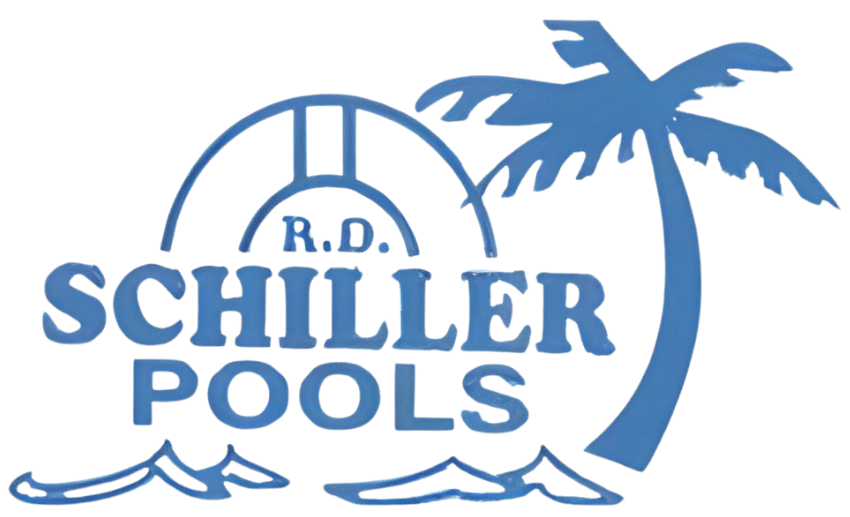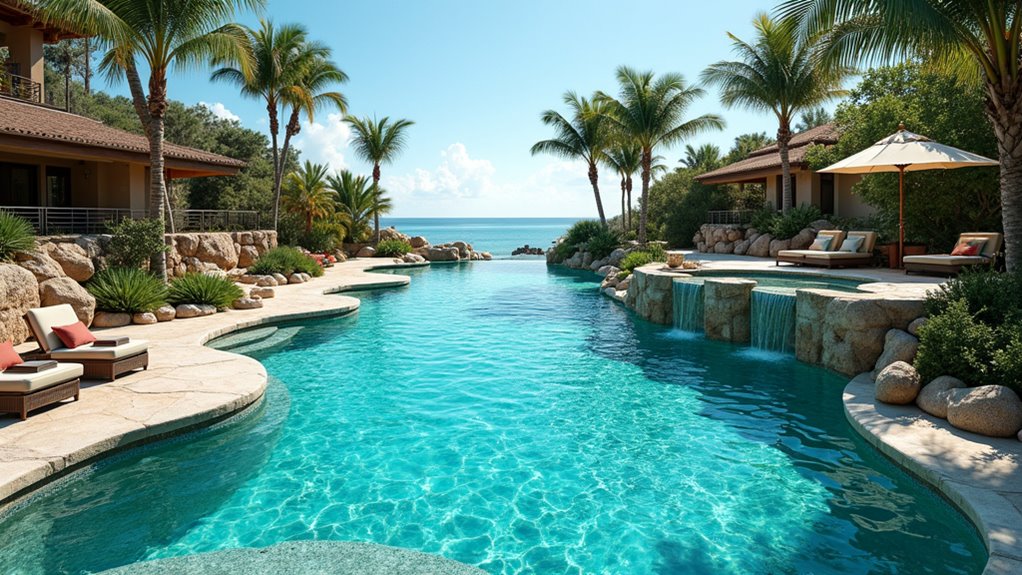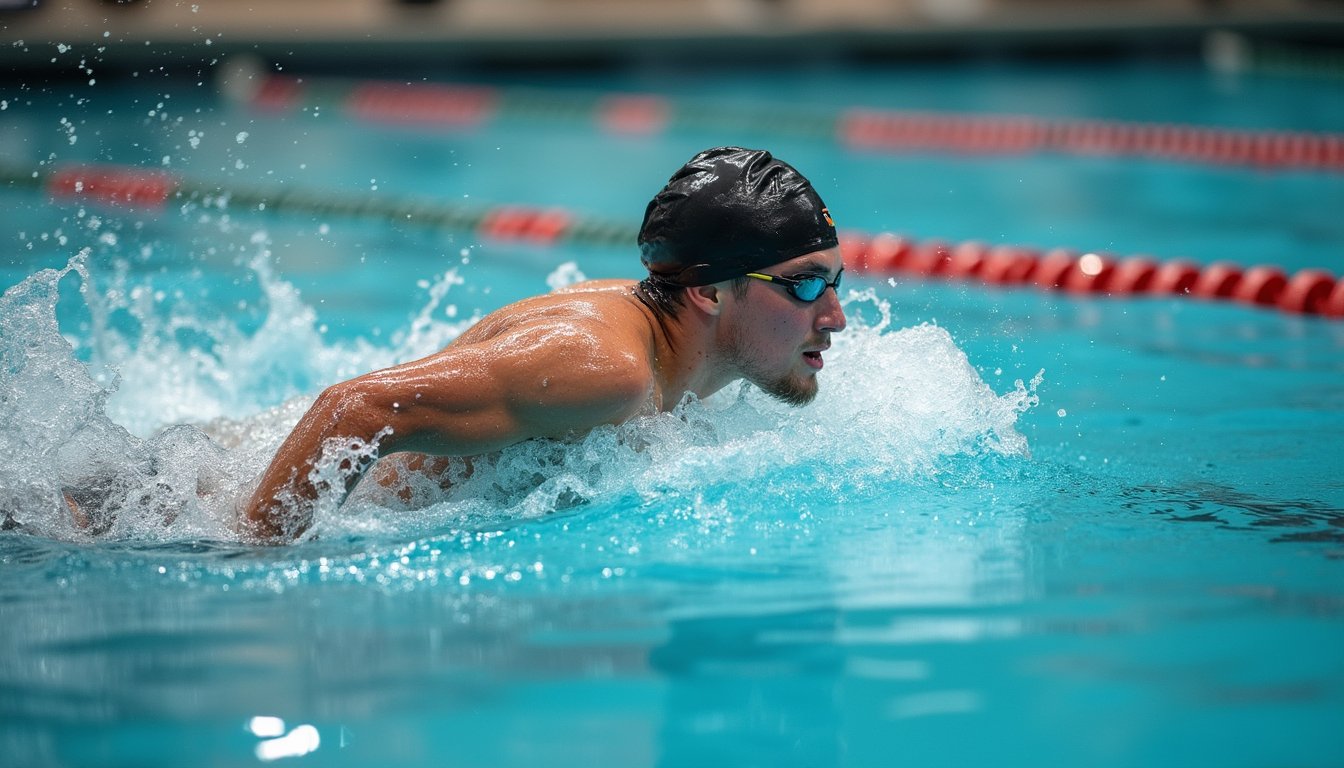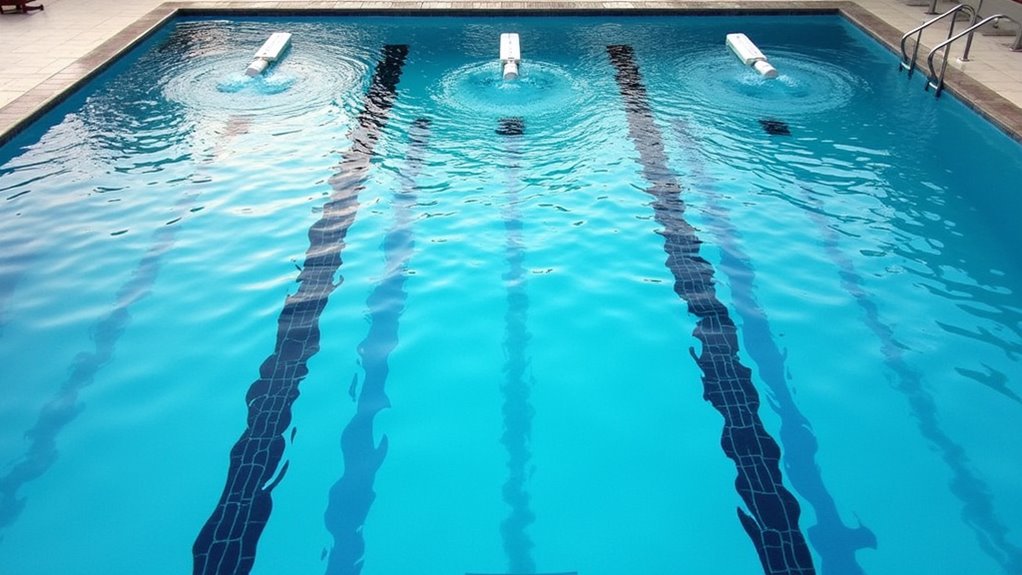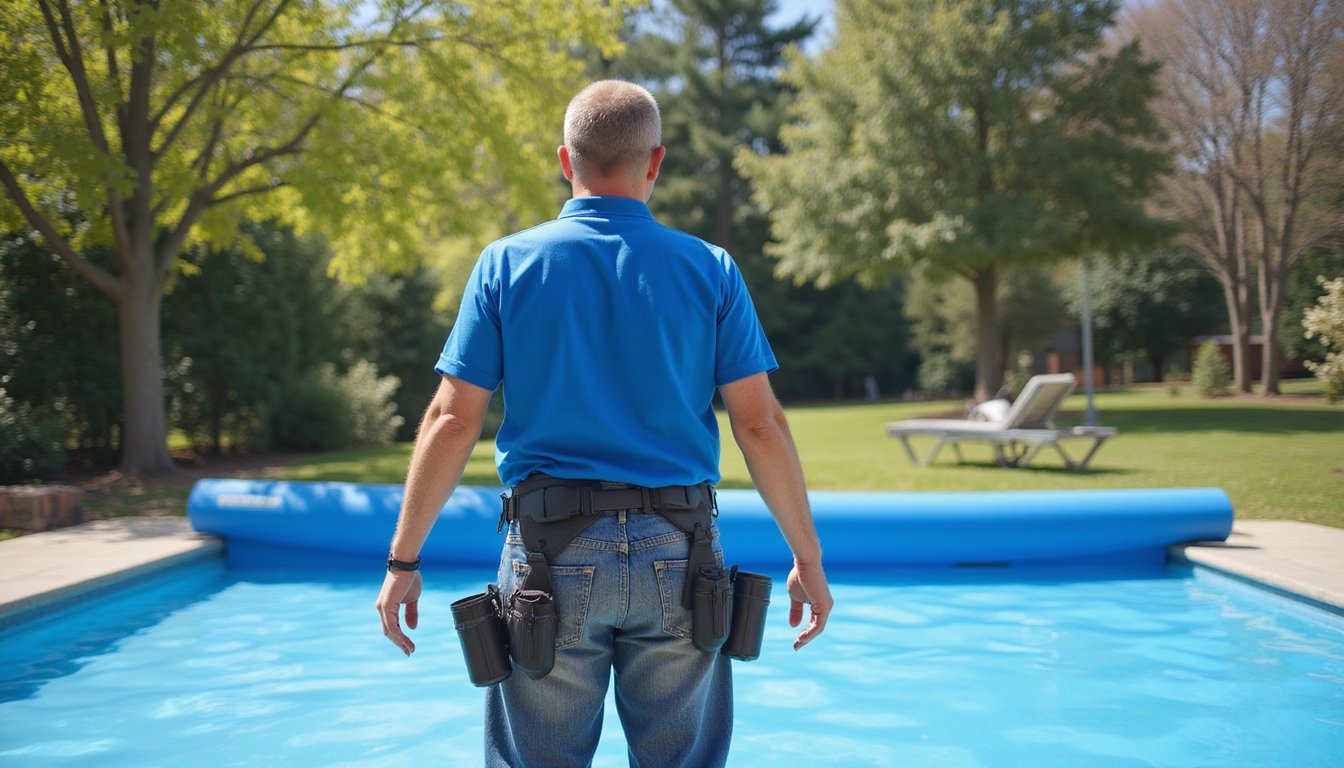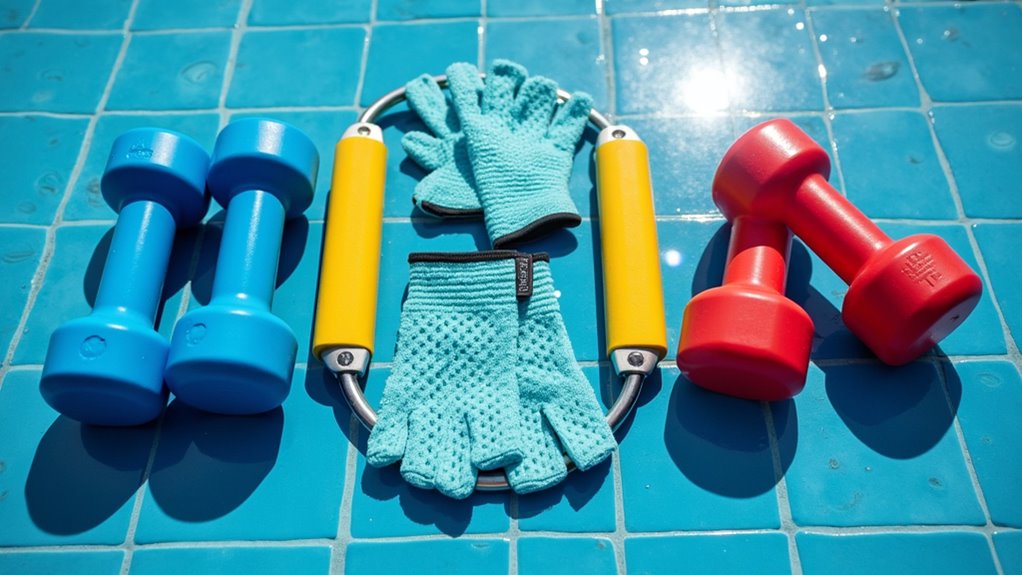To start pool resistance training, you’ll need three essential pieces of equipment: water dumbbells for upper body workouts, a water jogging belt for deep water exercises, and webbed gloves for amplified resistance control. Choose dumbbells with foam construction for suitable buoyancy, and guarantee your jogging belt provides secure waist positioning for ideal form. Don’t forget to assess all equipment for proper fit and flotation before beginning your workout. Comprehending supplementary gear options will help maximize your aquatic fitness routine.
Essential Water Dumbbells for Building Strength

When you’re ready to begin pool resistance training, selecting the right water dumbbells is pivotal for achieving ideal strength gains. Look for foam and plastic construction that’s lightweight outside the pool but creates substantial resistance when submerged. These specialized tools are perfect for shallow water exercises and comprehensive strength endurance training. Low-impact training helps protect your joints during intense aquatic workouts. The resistance provides force in all directions, making your muscles work harder to maintain stability and control.
Your water dumbbells should offer buoyant properties that enable controlled movements while providing multi-directional resistance. This design activates stabilizing muscles often missed in traditional workouts. You’ll attain ideal results by choosing dumbbells that allow you to adjust resistance through movement speed and tempo variations. The lightweight construction guarantees safe handling for all fitness levels, while the water’s natural resistance creates an effective training load that strengthens muscles without stressing your joints. Advanced models like FitMax Spabells can be connected to form barbells for expanded exercise options.
Water Jogging Belts for Deep Water Exercise
Water jogging belts provide essential flotation support that keeps your body properly aligned in a vertical position during deep water exercise. You’ll need to position the belt snugly around your waist, ensuring it sits just above your center of gravity to maintain ideal buoyancy and form while performing aqua jogging movements. The belt’s support allows you to focus on proper running technique while benefiting from water’s natural resistance, which can be up to four times greater in vertical positions compared to horizontal swimming. This zero impact workout enables you to maintain cardiovascular fitness while completely eliminating stress on your joints and bones. The resistance provided by water during aqua jogging delivers 12 times more resistance than exercising in air, making it an exceptionally effective strength training activity.
Belt Features and Benefits
Nearly all water jogging belts share essential features that optimize safety and effectiveness during deep water exercise. You’ll benefit from neutral buoyancy augmentation that eliminates sculling, allowing your body to maintain proper alignment while focusing on workout intensity optimization. The belt’s positioning at your waist creates an ideal center of gravity for water suspension. Aquatic therapy provides zero-impact exercise that reduces strain on joints and muscles. While some students resist wearing belts claiming strong swimming abilities, instructor liability concerns require their use during classes. Deep water running with proper belt support improves running form while providing resistance in all directions.
| Feature | Benefit | Safety Impact |
|---|---|---|
| EVA Foam | Permanent flotation | Prevents sinking |
| Waist Design | Proper alignment | Optimal suspension |
| Full Support | Arms move freely | Better cardio |
| Buoyant Core | Zero gravity feel | Emergency protection |
Your belt’s design enables extended range of motion while providing indispensable safety support during medical emergencies. This essential equipment transforms deep water sessions into effective resistance workouts while maintaining AEA safety standards.
Proper Positioning and Form
Maintaining proper form during deep water exercise requires mastering essential positioning techniques with your flotation belt. Start by securing the belt snugly around your waist, ensuring suitable buoyancy considerations for vertical stability. Keep your spine neutral and shoulders aligned directly over your hips while engaging your core muscles to prevent forward leaning. Webbed gloves can provide additional stability and control during your water workout. These techniques are essential for achieving a low-impact workout while maximizing cardiovascular benefits.
Focus on vertical alignment by maintaining an upright posture throughout your workout. You’ll need to resist the water’s natural tendency to push you off balance by keeping your back straight and abs tight. Position any supplementary equipment, such as water noodles, slightly higher behind your back than in front for improved support. The hydrostatic pressure of water helps support your body while exercising. Remember to use controlled arm movements close to your body while practicing the stabilizing scull technique to maintain proper form during deep water exercises.
Choosing the Right Flotation Support Equipment

When you’re starting pool resistance training, you’ll need essential flotation safety gear like properly fitted belts and buoys to maintain stability during exercises. You can choose from multiple pool support device types, including kickboards, noodles, and pull buoys, each designed to target specific muscle groups while providing reliable buoyancy assistance. Similar to how CloudFront enables efficient content delivery, proper distribution of resistance training equipment throughout the pool area ensures smooth workout flow. Position your flotation equipment correctly by securing belts at waist level, holding kickboards at chest height, and placing pull buoys between your thighs to optimize safety and training effectiveness. Adjustable swim vests with removable flotation panels can provide additional stability control as you progress through different exercise intensities. Beginners should consider shopping at retailers like SwimOutlet’s extensive selection to find the right equipment for their needs and skill level.
Essential Flotation Safety Gear
Proper flotation safety gear serves as your essential line of defense during pool resistance training. When selecting equipment, prioritize personal flotation considerations and conduct thorough safety certification analysis. You’ll need Coast Guard-approved devices that meet regulatory buoyancy standards for your specific needs.
| Type | Best For | Key Features |
|---|---|---|
| Type II | Deep Water | Head-up flotation |
| Type III | General Use | Movement freedom |
| Type V | Specialized | Activity-specific |
Ensure your gear fits properly based on weight guidelines and includes essential safety features like adjustable straps and crotch supports. You’ll want equipment made from non-toxic, durable materials with double air chambers when applicable. Choose bright colors with reflective elements for amplified visibility. Remember, proper flotation devices should provide adequate buoyancy without restricting your training movements.
Pool Support Device Types
Successful pool resistance training depends heavily on selecting appropriate flotation support devices that match your fitness goals and skill level. Different water-based buoy types serve distinct training purposes: pull buoys isolate arm movements by securing between your thighs, while kickboards enable focused leg training by occupying your hands.
For versatile support, pool noodles offer adaptable flotation device design that works for diverse exercises. Hand buoys and aqua dumbbells create targeted resistance for upper body strengthening, utilizing water’s natural properties for muscle development. When you need stable core support, buoyancy belts provide hands-free flotation during vertical exercises.
You’ll want to choose equipment based on your specific training objectives, whether it’s building arm strength, developing leg power, or improving general aquatic fitness performance.
Proper Equipment Positioning Tips
Three key principles guide effective flotation equipment positioning for pool resistance training: depth-based selection, secure anchoring, and proper body alignment. You’ll need to adjust your equipment based on water depth and participant height accommodations to guarantee optimal training effectiveness.
Follow these essential belt adjustment protocols for safety:
- Position waist belts snugly without restricting breathing
- Test flotation support before beginning intense exercises
- Maintain proper spinal alignment during deep water training
For shallow water exercises at mid-chest depth, you’ll require minimal flotation support. In deeper water, secure your pull buoys between your thighs for upper body workouts. Remember to anchor resistance bands only to permanent structures – never to movable pool furniture. Regular equipment checks and proper positioning will optimize your workout’s effectiveness while maintaining safety throughout your training session.
Webbed Gloves for Upper Body Training

Webbed gloves represent an essential tool for boosting upper body resistance training in the pool environment. By increasing surface area between your fingers, these specialized gloves create additional water resistance that’ll heighten your upper body muscle activation during aquatic exercises.
You’ll find two main options: fabric gloves, which offer superior flexibility and comfort, and neoprene versions that provide better warmth in cold conditions. For enhancing hand hydrodynamics, choose gloves with open-finger designs that allow natural movement while maintaining resistance. When selecting your gloves, guarantee a proper fit to prevent discomfort and optimize performance.
These gloves work by forcing your arms and shoulders to push against increased water resistance, effectively strengthening muscles while protecting your joints. They’re particularly beneficial for water aerobics, aqua jogging, and general pool-based resistance training.
Ankle Weights for Lower Body Resistance
When incorporating ankle weights into your pool training routine, you’ll uncover a powerful tool for enhancing lower body resistance and muscle development. These adjustable accessories provide 800 times greater resistance than air-based training while protecting your joints through controlled aquatic movements.
For effective progression and safety, focus on these essential steps:
- Start with shallow-end walking exercises to establish proper form
- Select graduated weight increments suitable for your fitness level
- Master knee-to-chest movements before advancing to multi-plane leg raises
Proper weight selection is indispensable for beginners. You’ll benefit from reduced buoyancy and amplified stability while targeting glutes, hamstrings, and calves. The lightweight construction allows easy transport, while Velcro fasteners secure attachment during your workout. This equipment dramatically increases caloric burn while promoting faster muscle recovery compared to land-based training.
Pool Noodles and Their Versatile Applications
Although pool noodles might seem like simple foam toys, they’re actually versatile resistance tools that can revolutionize your aquatic workout routine. When selecting your equipment, opt for solid core noodles rather than hollow versions, as they’ll provide superior resistance levels for training.
You’ll find that pool noodles create natural buoyancy intensity during exercises, forcing your muscles to work against water’s upward force. This resistance automatically adjusts to your effort level, making workouts both safe and effective. You can perform upper body movements like arm curls and figure-8 patterns, while also incorporating core-strengthening exercises through noodle planks and balance work.
Remember to check your noodle’s condition regularly, as waterlogged or older equipment won’t deliver the sturdiness needed for ideal training results.
Kickboards for Balance and Core Training
A kickboard serves as your foundational training tool for developing proper balance and core strength in the pool. When you hold the board correctly, it provides essential flotation support while isolating your leg movements, allowing you to focus entirely on kick frequency adjustments and proper technique.
Master your swimming fundamentals with a kickboard, the perfect tool for isolating leg movements and building essential balance and core strength.
You’ll strengthen multiple muscle groups simultaneously as the water resistance engages your:
- Core stabilizers for maintaining streamlined position
- Quadriceps and hamstrings for power generation
- Glutes and hip flexors for stroke length augmentation
Your kickboard training naturally progresses from basic balance support to advanced resistance work. By positioning the board vertically in “tombstone” or “shark-fin” positions, you’ll create additional resistance that challenges your core strength and shoulder stability. This versatility makes kickboards indispensable for both technique refinement and strength development.
Safe Equipment Storage and Maintenance
After each pool workout, you’ll need to thoroughly dry all resistance equipment before storing it to prevent mildew and maintain equipment longevity. Organize your storage space with designated areas for different equipment types, using wall-mounted racks or shelving units to optimize vertical space and keep items off the pool deck. Your storage solution should allow for proper air circulation while keeping equipment easily accessible and protected from pool chemicals and direct sunlight.
Proper Equipment Drying Methods
Since proper drying techniques directly impact equipment longevity, you’ll need to establish a systematic maintenance routine for your pool resistance gear. Rinse all equipment with fresh water after each use to prevent chlorine damage and material degradation. Pay special attention to closed-cell EVA foam components, which require thorough air-drying in well-ventilated areas to avert bacteria growth.
For ideal equipment maintenance and longevity:
- Air-dry foam equipment for 2-4 hours in a well-ventilated space, away from direct sunlight
- Turn neoprene components inside-out during drying to guarantee complete moisture removal
- Test fabric straps and velcro attachments after each drying cycle to verify structural integrity
Don’t store equipment until completely dry, as trapped moisture can lead to bacterial growth and accelerated material breakdown, compromising your gear’s safety and performance.
Storage Space Organization Tips
Proper storage organization sets up your pool resistance training equipment for ideal longevity and safety. You’ll need to implement systematic equipment inventory tracking and clear staff training protocols to maintain your gear effectively.
| Storage Zone | Purpose | Safety Requirement |
|---|---|---|
| Wet Area | Quick-dry equipment | Non-slip surfaces |
| Resistance Gear | Weight organization | Height-appropriate shelving |
| Foam Equipment | Impact protection | Moisture-free storage |
| Training Tools | Daily access items | Clear visibility |
| Maintenance | Cleaning supplies | Ventilation control |
Store your resistance equipment in raised bins to prevent ground contact and separate wet gear from dry items. Position frequently used equipment at easily accessible heights and maintain clear pathways for emergency access. Establish regular inspection schedules and rotate equipment to guarantee even wear. Remember to keep cleaning supplies nearby for immediate maintenance needs.
Recommended Starter Equipment Packages
When starting pool resistance training, selecting the right equipment package guarantees a safe and effective introduction to aquatic workouts. You’ll find that entry-level packages featuring EVA foam water weights and basic resistance tools offer quality performance considerations without overwhelming complexity.
For ideal features and benefits, consider these essential starter packages:
- Basic water weight sets ($20-$80) with high-density foam construction
- Speedo Kickboard combinations with comfort accessories
- Hydro-Bells and Aquastrength Fins bundles ($139.95) for full-body training
You’ll want to prioritize equipment that’s USA-manufactured and meets international quality standards. Look for packages that include structured workout programs and scalable resistance options. Multi-purpose resistance kits can amplify your investment while providing broad training capabilities for both upper and lower body exercises.
Progressive Training Equipment Selection
Building upon your starter equipment foundation, progressive training gear allows you to advance your pool workouts systematically. As you develop strength and confidence in your resistance training patterns, you’ll need equipment that provides greater challenge and versatility.
Consider upgrading to adjustable water dumbbells with interchangeable resistance plates to customize your workout intensity. Add webbed gloves and ankle cuffs with variable resistance settings to fortify your pool exercise progressions. For advanced movements, incorporate aquatic resistance bands that attach to the pool wall or specialized underwater bars.
Always select equipment certified for pool use and rated for your specific water depth. Guarantee each piece features quick-release mechanisms for safety and non-corrosive materials for durability. Start with lighter resistance options and gradually increase as your technique and strength improve.
Frequently Asked Questions
How Long Should Beginners Spend on Each Resistance Exercise in the Pool?
Start with 12-15 repetitions per exercise, focusing on proper exercise technique rather than speed. You’ll want to maintain each movement for 1-3 sets, with 20-30 seconds rest between sets. If you’re using resistance equipment like hand webs or kickboards, continue until you feel muscle fatigue. For your resistance progression goals, aim to increase sets or duration only after you’ve mastered proper form with minimal fatigue.
Can Pool Resistance Equipment Be Used in Saltwater Pools?
You’ll need to carefully select your resistance equipment for saltwater pools, as not all gear is compatible. Choose resin-based or specialized saltwater pool equipment designed to withstand corrosion. While you can use some metal equipment, it’ll require frequent saltwater pool maintenance considerations, including regular inspections and cleaning. For best results, opt for non-metallic polymer materials or equipment with high-grade stainless steel components that are specifically rated for saltwater environments.
What’s the Best Water Temperature for Resistance Training With Equipment?
For ideal resistance training with equipment, you’ll want water temperatures between 83-86°F (28.3-30°C). When you’re maintaining proper body alignment during exercises, this temperature range helps your muscles work efficiently without overheating. For high-intensity sessions, stay closer to 83°F; for longer workouts, you’ll benefit from slightly cooler temperatures. The perfect water depth for resistance training should allow you to maintain proper form while keeping your shoulders submerged.
Should Beginners Wear Water Shoes During Pool Resistance Workouts?
Yes, you should definitely wear water shoes during pool resistance workouts. They’ll provide proper ankle support and essential traction, reducing your risk of slipping in varying pool depth requirements. You’ll also benefit from 20-30% more resistance during leg movements, enhancing your workout effectiveness. For safety, choose shoes with sticky soles and adequate drainage. They’re particularly pivotal when you’re learning proper form and protecting your feet from rough pool surfaces.
How Many Times per Week Should Beginners Do Pool Resistance Training?
You’ll need to train 2-3 times per week for best results in pool resistance training. Each session’s ideal workout duration should be 30-45 minutes, allowing your muscles and cardiovascular system to properly adapt. It is crucial to maintain proper exercise form throughout and leave at least one day between sessions for recovery. Don’t exceed three sessions weekly as a beginner, as your body needs time to adjust to this unique form of resistance training.
